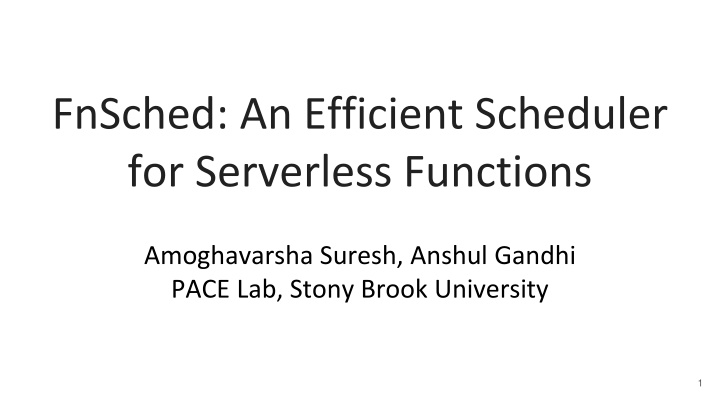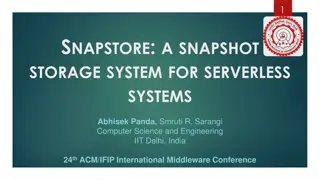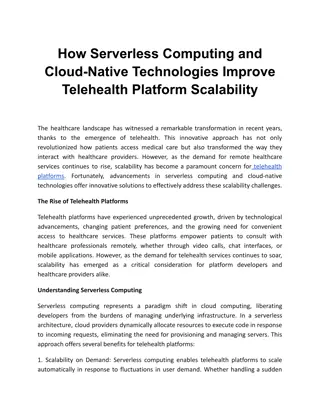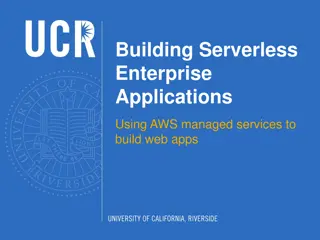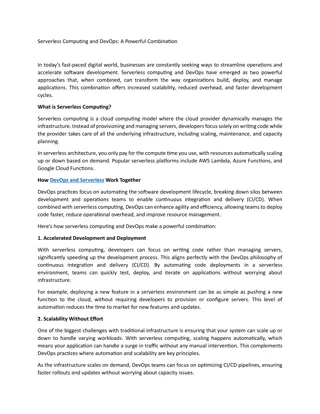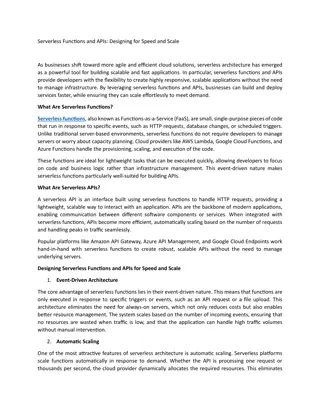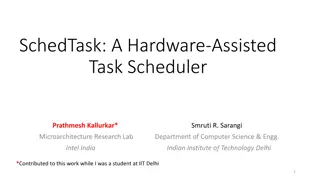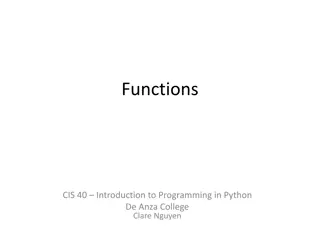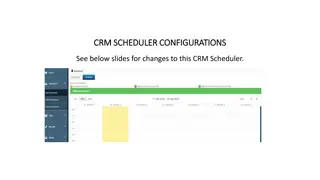Efficient Scheduler for Serverless Functions
FnSched is an efficient scheduler designed to address challenges in serverless computing, such as application diversity, container management, and resource allocation. With a focus on improving resource usage and performance, FnSched aims to enhance the user experience and optimize provider costs. This innovative approach offers benefits like easy deployment, increased scalability, and enhanced programmer productivity. Explore the motivation, design principles, and evaluation of FnSched in this insightful research.
Download Presentation

Please find below an Image/Link to download the presentation.
The content on the website is provided AS IS for your information and personal use only. It may not be sold, licensed, or shared on other websites without obtaining consent from the author.If you encounter any issues during the download, it is possible that the publisher has removed the file from their server.
You are allowed to download the files provided on this website for personal or commercial use, subject to the condition that they are used lawfully. All files are the property of their respective owners.
The content on the website is provided AS IS for your information and personal use only. It may not be sold, licensed, or shared on other websites without obtaining consent from the author.
E N D
Presentation Transcript
FnSched: An Efficient Scheduler for Serverless Functions Amoghavarsha Suresh, Anshul Gandhi PACE Lab, Stony Brook University 1
Motivation Serverless computing is becoming popular Features: - Providers responsible for resource management - Pay-for-what-you-use (runtime) Benefits: - Easy deployment: Write your code and ship it! - Increases programmer productivity - Seemingly infinite scalability 2
Motivation Interest from different domains - Edge-Triggered applications: e.g. Web apps, backends, data preprocessing - Massively Parallel applications: e.g. MapReduce, Stream Processing - Serverless offers cost benefits: 20 per 1M lambda requests - Ex-Camera [NSDI 17] serverless video encoding is 60x faster and 6x cheaper than VM based (serverful) solution. Interest in serverless computing will rise. For a viable service: - Efficient resource usage @ scale is important for the provider - Reasonable performance is important for the user - - Smart scheduling and resource management is critical 3
Outline - Motivation - Scheduling Challenges - FnSched Design - Evaluation - Conclusion & Future work 4
Scheduling challenge 1/3: Application Diversity Increased Interest -> Application diversity Edge-Triggered applications: - - Short-lived, lightweight - e.g. Web apps, backends, data preprocessing Massively Parallel applications: - - Long running, computationally intensive - E.g. MapReduce, Stream Processing 5
Scheduling challenge 2/3: Containers Serverless applications are hosted on containers - Absence of running container results in Cold Start - Cold-Start: - Application execution is delayed, e.g. ~3s in our setup - Should minimize the number of cold-starts - Application Execution App Specific Initialization Runtime Initialization Container Creation 6
Scheduling challenge 3/3: Allocation & Placement Strawman: Allocate a core for each application - However, provider cost will escalate!! - Solution: Effective packing - - Where to place a container? - Whether to colocate a container? - How long should the container be alive? - Whether to add new nodes? 7
FnSched Approach - Goal: Target a maximum degradation latency and minimize the number of servers/invokers used. FnSched Approach Colocation Packing, Proactive Spawning 8
FnSched: Resource Management - - Popular Serverless platforms tie CPU allocation to memory requirement CPU requirement is dependent on the class of applications ET MP C1 C2 C3 C4 - - Short running ET apps are severely impacted compared to MP apps We need to decouple memory and CPU requirement for effective colocation 9
FnSched: CPU Shares Algorithm CPU Shares: Soft limit, decides proportion of CPU during contention ET MP C1 C2 C3 C4 Allocate more of CPU time to short running ET during contention! 10
FnSched: CPU Shares Algorithm CPU Shares: Soft limit, decides proportion of CPU during contention ET C1 MP C2 C3 C4 - - - When to increase the cpushares? How much to increase? How to balance the cpu shares? 11
FnSched: CPU Shares Algorithm numUpdatesThd When to increase the cpushares? cpuSharesStep How much to increase? maxCpuShares How to balance the cpu shares? - - - 12
Multi Node Placement: Packing - Packaging: Greedy algorithm based on data center power management policy. I-2 I-N I-1 - - - Allocate request in the smallest index invoker Helps to packing requests in as few invokers as possible With effective packing, higher index invokers can be turned off 13
Multi Node Placement: Proactive Spawning - Packaging: Greedy algorithm based on data center power management policy. I-2 I-N I-1 - Cold Starts: Scheduling on invoker k is followed by proactively spawning an application container on invoker k+1 14
Outline - Motivation - Scheduling Challenges - FnSched Design - Evaluation - Conclusion & Future work 15
Experimental Setup - OpenWhisk Cluster: 10 VMs Front-end + control plane: 2 VMs Invokers: 8 VMs Distributed services: Storage: CephFS, Database: Redis, Stream Processing: Apache Kafka Applications: Edge-Triggered: Image Resizing (IR), Streaming Analytics (SA) Massively Parallel: Nearest Neighbors (NN) Computational Fluid Dynamic (CFD) solver latencyThd: 1.15 i.e. maximum of 15% performance degradation HTTP Frontend - - Controller - - Invoker-1 Invoker-8 - - Distributed Services - Ceph FS Redis DB Apache Kafka - - - - 16
Single Node Evaluation - - - FnSched: Single node resource allocation Linux: CPU shares 1024 OpenWhisk: CPU shares proportional to memory Can safely co-locate 17
Multinode Evaluation: Scaling - - - FnSched: Single node resource allocation LeastConnections (LC): Choose the invoker with least outstanding requests RoundRobin (RR): Send successive requests to different invokers in a cyclic manner Packing can scale and maintain performance FnSched uses 31% fewer invokers compared to LC, and 62% compared to RR 18
Multi Node Evaluation: Traces Load: - IR - NN Scheduling: - FnSched - LeastConnections FnSched uses 36% fewer invokers compared to LC, and 55% compared to RR - RoundRobin Traces: - - Synthetic (top) WITS (bottom) 19
Conclusion - Presented a work-in-progress serverless scheduling algorithm based on colocation + packing - CPU Shares algorithm: Reduces degradation compared to SoA - Packing + Proactive Spawning: Maintains acceptable performance, While reducing invoker usage by 36% compared to LC, 55% compared to RR - 20
Q&A 21
Future Work Proactive Spawning : Figure out ~exact number of containers required Evaluation: Scenarios where colocation opportunities are fewer Multiple ET applications ET:MP ratio is > 1 Compare against Knative - - - - - 23
FnSched Approach - Goal: Target a maximum degradation latency and minimize the number of servers/invokers used. Challenges FnSched Approach Application Diversity/ Resource management Application class based colocation, resource management Cold-Start Proactive Spawning Allocation & Placement Packing based on data center power management policy 24
Sensitivity Analysis Choose parameters for single node resource allocation algorithm. Parameters vary for application class - numUpdatesThd: Minimum iterations required before updating cpu-shares - maxCpuShares: Ceiling of the cpu-shares per container, maximum of 1024 - cpuSharesStep: Per iteration increment of cpu-shares - updateLatencyThd: Minimum degradation before updating cpu-shares 1.10 Appln Class numUpdatesThd maxCpuShares cpuSharesStep 5 768 128 ET 3 256 64 MP 25
Multi Node Placement: Latency monitoring - Packaging: Greedy algorithm based on data center power management policy. I-2 I-N I-1 - - - Monitor average latency Based on threshold latency, mark invoker to be in safe, warning, unsafe zone Capacity of invoker varies by the zone 26
